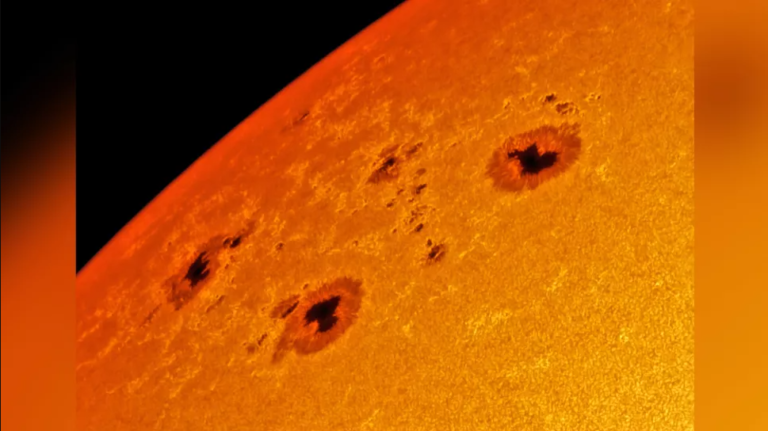A gigantic sunspot has swelled to twice Earth’s size, doubling its diameter in 24 hours, and it’s pointed right at us.
Earth will remain in the sunspot’s crosshairs for a few more days.
A gigantic sunspot has swelled to twice Earth’s size, doubling its diameter in 24 hours, and it’s pointed right at us.
The sunspot, called AR3038, grew to 2.5 times Earth’s size — making the sunspot roughly 19,800 miles, or 31,900 kilometers, in diameter — from Sunday (June 19) to Monday night (June 20), according to Spaceweather.com, a website that tracks news about solar flares, geomagnetic storms and other cosmic weather events.
Sunspots are dark patches on the sun’s surface where powerful magnetic fields, created by the flow of electric charges from the sun’s plasma, knot before suddenly snapping. The resulting release of energy launches bursts of radiation called solar flares and generates explosive jets of solar material called coronal mass ejections (CMEs).
“Yesterday, sunspot AR3038 was big. Today, it’s enormous. The fast-growing sunspot has doubled in size in only 24 hours,” Spaceweather.com reported. “AR3038 has an unstable ‘beta-gamma’ magnetic field that harbors energy for M-class [medium-sized] solar flares, and it is directly facing Earth.”
When a solar flare hits Earth’s upper atmosphere, the flare’s X-rays and ultraviolet radiation ionize atoms, making it impossible to bounce high-frequency radio waves off them and creating a so-called radio blackout. Radio blackouts occur over the areas on Earth that are lit by the sun while a flare is underway; such blackouts are classified from R1 to R5 according to ascending severity.
In April and May, two solar flares caused R3 blackouts over the Atlantic Ocean, Australia and Asia, Live Science previously reported. As solar flares travel at the speed of light, they take only 8 minutes to reach us, from an average distance of about 93 million miles (150 million kilometers).
If an Earth-facing sunspot forms near the sun’s equator (where AR3038 is located), it typically takes just under two weeks for it to travel across the sun so that it is no longer facing Earth, according to SpaceWeatherLive. Currently, AR3038 lies slightly to the north of the sun’s equator and is just over halfway across, so Earth will remain in its crosshairs for a few more days.
Despite its alarmingly speedy growth, the giant sunspot is less scary than it may seem. The flares it will most likely produce are M-class solar flares, which “generally cause brief radio blackouts that affect Earth’s polar regions,” alongside minor radiation storms, the European Space Agency wrote in a blog post. M-class flares are the most common type of solar flare. Although the sun does occasionally release enormous X-class flares (the strongest category) with the potential to cause high-frequency blackouts on the side of Earth that’s exposed to the flare, these flares are observed much less often than smaller solar eruptions.
Sunspots can also belch solar material. On planets that have strong magnetic fields, like Earth, the barrage of solar debris from CMEs is absorbed by our magnetic field, triggering powerful geomagnetic storms. During these storms, Earth’s magnetic field gets compressed slightly by the waves of highly energetic particles, which trickle down magnetic-field lines near the poles and agitate molecules in the atmosphere, releasing energy in the form of light to create colorful auroras in the night sky.
The movements of these electrically charged particles can disrupt our planet’s magnetic field powerfully enough to send satellites tumbling to Earth, Live Science previously reported, and scientists have warned that extreme geomagnetic storms could even cripple the internet. Erupting debris from CMEs usually takes around 15 to 18 hours to reach Earth, according to the National Oceanic and Atmospheric Administration’s (NOAA) Space Weather Prediction Center.
Astronomers have known since 1775 that solar activity rises and falls according to a roughly 11-year cycle, but recently, the sun has been more active than expected, with nearly double the sunspot appearances predicted by NOAA. The sun’s activity is projected to steadily climb for the next few years, reaching an overall maximum in 2025 before decreasing again.
Scientists think the largest solar storm ever witnessed during contemporary history was the 1859 Carrington Event, which released roughly the same energy as 10 billion 1-megaton atomic bombs. After slamming into Earth, the powerful stream of solar particles fried telegraph systems all over the world and caused auroras brighter than the light of the full moon to appear as far south as the Caribbean. If a similar event were to happen today, scientists warn, it would cause trillions of dollars in damage and trigger widespread blackouts, much like the 1989 solar storm that released a billion-ton plume of gas and caused a blackout across the entire Canadian province of Quebec, NASA reported.
Originally published on Live Science.
Do not forget to share your opinion with us to provide you with the best posts !




0 Comments